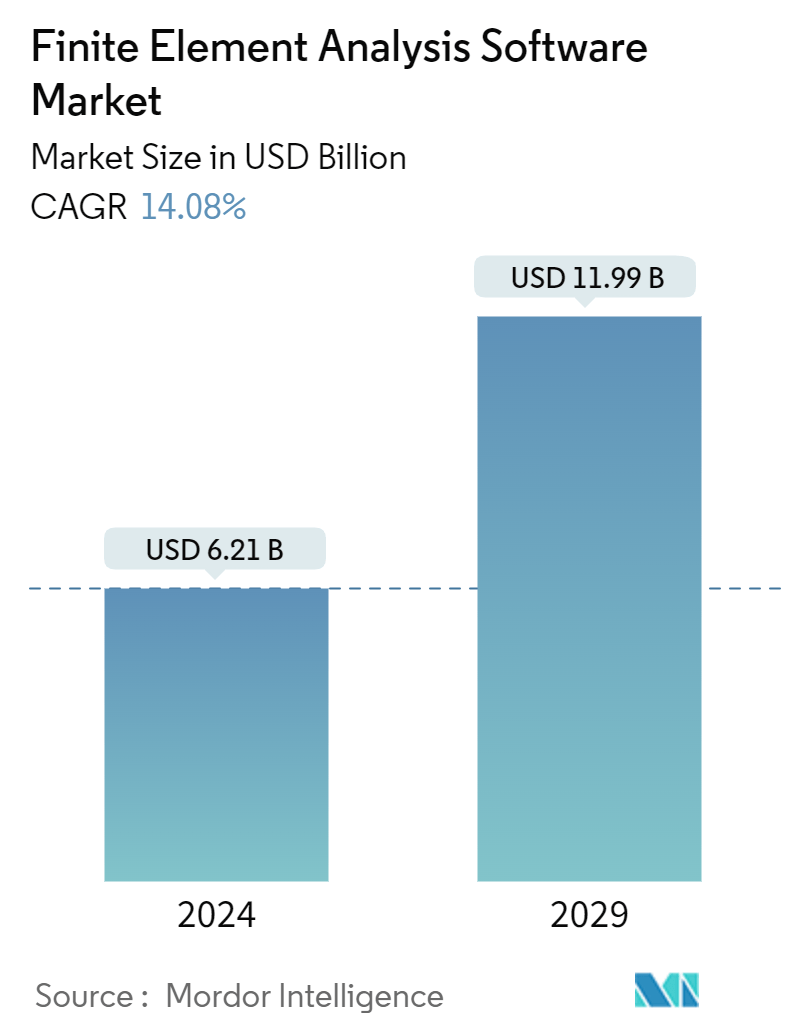Market Size of Finite Element Analysis Software Industry

| Study Period | 2022 - 2029 |
| Market Size (2024) | USD 6.21 Billion |
| Market Size (2029) | USD 11.99 Billion |
| CAGR (2024 - 2029) | 14.08 % |
| Fastest Growing Market | Asia Pacific |
| Largest Market | North America |
Major Players
*Disclaimer: Major Players sorted in no particular order |
Finite Element Analysis Software Market Analysis
The Finite Element Analysis Software Market size is estimated at USD 6.21 billion in 2024, and is expected to reach USD 11.99 billion by 2029, growing at a CAGR of 14.08% during the forecast period (2024-2029).
- The global finite element analysis software market growth is governed by the increasing adoption of virtual prototyping, the rising demand for safety and comfort in modern automobiles, coupled with the growing need to create higher-quality products in a reduced design cycle, minimizing material and time waste. This trend is further fueled by a rising demand for lightweight, energy-efficient designs and the escalating complexity of product designs.
- As governments worldwide tighten regulatory standards, the demand for simulation techniques to ensure safety and reliability has seen a notable uptick, indicating a positive market outlook.
- Technological advancements in the FEA software landscape, such as the shift toward cloud-based solutions, are further augmenting the adoption of FEA software across industries worldwide. Businesses across diverse sectors are increasingly making substantial shifts in their approach to product development and innovation, further propelling market growth. This heightened adoption underscores the pivotal role of FEA software in boosting precision and simultaneously reducing the time and costs associated with physical prototypes.
- The rising demand and production of electric and hybrid vehicles, coupled with an increase in fuel production and consumption, drives the growth of the global finite element analysis software market. Electric and hybrid vehicles (EHVs) are lauded for their environmental benefits and fuel efficiency.
- However, they also introduce vehicle design and performance challenges, such as the vibration and noise generated by the electric motor, battery, and powertrain. Such disturbances can compromise the vehicle's comfort, safety, and the longevity of its components. In response, the demand for FEA software to simulate and refine the dynamic behavior of both the vehicle and its parts is growing, driving the growth of the market.
- The intricate nature of FEA software necessitates recruiting highly skilled professionals capable of conducting advanced analyses. Such recruitment demands a considerable investment of time and financial resources, potentially dissuading companies from embracing FEA solutions. This challenge is pronounced for smaller firms with limited budgets and countries lacking a robust pool of FEA-trained engineers.
- Geopolitical risks from elections, polarization, and conflicts within and between states significantly impact both global and national economies. The ongoing geopolitical concerns worldwide, notably the Russia-Ukraine War and Middle-East crisis, have a lasting impact on the global finite element analysis software market.
Finite Element Analysis Software Industry Segmentation
Finite element analysis (FEA) is referred to as a computerized method to predict how a product reacts to real-world forces, vibration, heat, fluid flow, and other physical effects. It shows whether a product will break, wear out, or work as expected and designed. FEA simulation is used to predict what will happen in the product development process when the product is used in its real-world application. This is aimed to ensure that it achieves whatever tasks that component needs to perform safely and efficiently.
The Finite Element Analysis software market is segmented by deployment (on-premise and cloud), by enterprise size (small and medium enterprises (SMEs) and large enterprises), by application (construction, electrical and electronic manufacturing, aerospace and defense, oil, gas, and energy, architecture and planning, technology hardware and software, automotive, other applications), and by geography (North America (United States, Canada), Europe (Nordics, Germany, United Kingdom, France, and the rest of Europe), Asia Pacific, and the rest of the World). The report provides market forecasts and size in value (USD) for all the above segments.
| By Deployment | |
| On-Premise | |
| Cloud |
| By Organization Size | |
| Small and Medium Enterprises (SMEs) | |
| Large Enterprises |
| By Application | |
| Construction | |
| Electrical and Electronic Manufacturing | |
| Aerospace and Defense | |
| Oil, Gas, and Energy | |
| Architecture and Planning | |
| Technology Hardware and Software | |
| Automotive | |
| Other Applications |
| By Geography*** | |||||||
| |||||||
| |||||||
| Asia | |||||||
| Australia and New Zealand | |||||||
| Latin America | |||||||
| Middle East and Africa |
Finite Element Analysis Software Market Size Summary
The Finite Element Analysis (FEA) Software Market is poised for significant expansion over the forecast period, driven by the increasing demand for simulation-based software across various industries such as aerospace, automotive, and construction. This growth is fueled by advancements in cloud computing and the rising need for product design optimization. In the oil and gas sector, FEA software plays a crucial role in analyzing the structural behavior of components like offshore platforms and pipelines, ensuring their strength and stability under various conditions. The software's application extends to optimizing the performance of equipment and simulating fluid and gas behavior, which is vital for the industry's operational efficiency. The robust demand for petroleum fuels and the complex processes involved in oil production and distribution further contribute to the market's growth prospects.
In the construction industry, FEA software is essential for ensuring the structural integrity and safety of projects by analyzing how structures respond to different loading conditions. The European region, in particular, is experiencing a surge in construction activities, which is expected to boost the market. The automotive sector also presents significant growth opportunities, with increasing vehicle production and the rise of electric vehicles driving demand for FEA software. Despite the high costs and specialized knowledge required for implementation, the market remains semi-consolidated with key players like ANSYS, Altair Engineering, and Bentley Systems continuously innovating to meet evolving consumer needs. Recent developments, such as the integration of FEA tools in aircraft engine development and the release of cloud-native simulation software, highlight the industry's commitment to advancing technology and enhancing productivity.
Finite Element Analysis Software Market Size - Table of Contents
-
1. MARKET INSIGHTS
-
1.1 Market Overview
-
1.2 Technology Snapshot
-
1.3 Industry Value Chain Analysis
-
1.4 Industry Attractiveness - Porter's Five Forces Analysis
-
1.4.1 Bargaining Power of Suppliers
-
1.4.2 Bargaining Power of Buyers
-
1.4.3 Threat of Substitute Products and Services
-
1.4.4 Degree of Competition
-
1.4.5 Threat of New Entrants
-
-
-
2. MARKET SEGMENTATION
-
2.1 By Deployment
-
2.1.1 On-Premise
-
2.1.2 Cloud
-
-
2.2 By Organization Size
-
2.2.1 Small and Medium Enterprises (SMEs)
-
2.2.2 Large Enterprises
-
-
2.3 By Application
-
2.3.1 Construction
-
2.3.2 Electrical and Electronic Manufacturing
-
2.3.3 Aerospace and Defense
-
2.3.4 Oil, Gas, and Energy
-
2.3.5 Architecture and Planning
-
2.3.6 Technology Hardware and Software
-
2.3.7 Automotive
-
2.3.8 Other Applications
-
-
2.4 By Geography***
-
2.4.1 North America
-
2.4.1.1 United States
-
2.4.1.2 Canada
-
-
2.4.2 Europe
-
2.4.2.1 Nordics
-
2.4.2.2 Germany
-
2.4.2.3 United Kingdom
-
2.4.2.4 France
-
2.4.2.5 Rest of Europe
-
-
2.4.3 Asia
-
2.4.4 Australia and New Zealand
-
2.4.5 Latin America
-
2.4.6 Middle East and Africa
-
-
Finite Element Analysis Software Market Size FAQs
How big is the Finite Element Analysis Software Market?
The Finite Element Analysis Software Market size is expected to reach USD 6.21 billion in 2024 and grow at a CAGR of 14.08% to reach USD 11.99 billion by 2029.
What is the current Finite Element Analysis Software Market size?
In 2024, the Finite Element Analysis Software Market size is expected to reach USD 6.21 billion.

